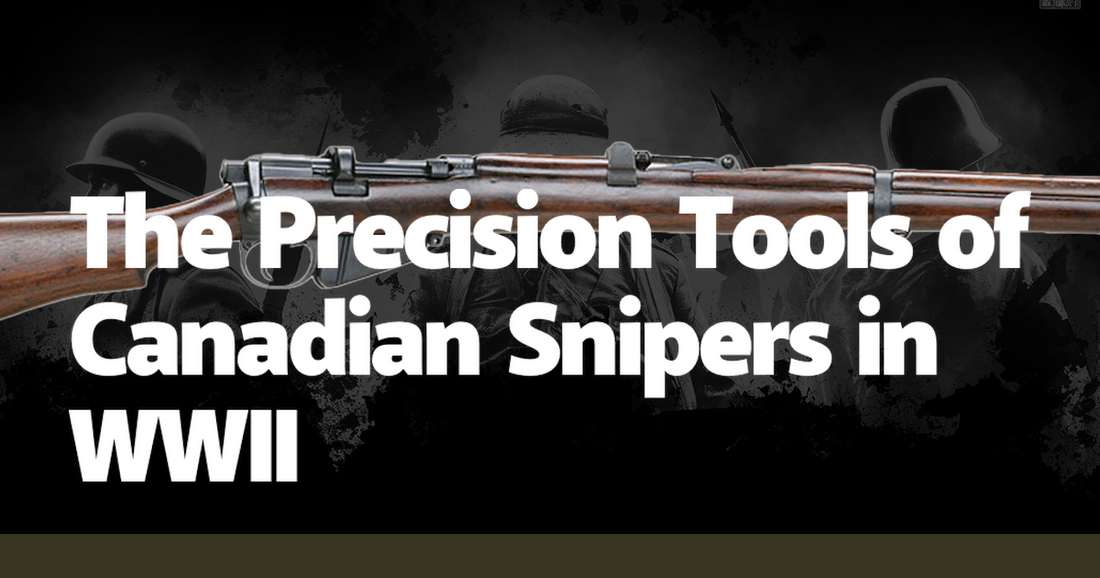In the crucible of World War II, Canadian snipers emerged as some of the most skilled and feared marksmen on the battlefield. Their success was not merely a product of their training and natural aptitude but also a result of the precision tools they wielded. Among these, the Lee-Enfield No.4 Mk I(T) sniper rifle stood out as a paragon of accuracy and reliability. This rifle, with its robust construction and impeccable craftsmanship, became the backbone of Canadian sniper operations. The Lee-Enfield’s ability to maintain accuracy under harsh conditions was unmatched, making it an indispensable asset in the varied and often brutal landscapes of the European theater.
The Lee-Enfield No.4 Mk I(T) was meticulously modified for sniper use. Each rifle was hand-selected for its accuracy potential before being sent to the renowned Holland & Holland gunsmiths in London. There, they were fitted with a No. 32 telescopic sight, a marvel of wartime optics. This scope provided a clear and precise view of targets at distances up to 800 yards, a significant advantage in both defensive and offensive operations. The reticle was designed to facilitate quick adjustments for windage and elevation, critical factors in ensuring the first shot was the only shot needed. The craftsmanship of Holland & Holland ensured that each rifle was not only a tool of war but a work of art, blending functionality with an elegance that belied its deadly purpose.
Canadian snipers were trained to an exacting standard, with emphasis on marksmanship, fieldcraft, and the psychological resilience needed to operate alone or in small teams behind enemy lines. Their training emphasized the importance of understanding their tools intimately. They were taught to disassemble, clean, and reassemble their rifles blindfolded, ensuring that they could maintain their weapons in any condition. This intimate knowledge extended to the ammunition they used. The .303 British round, known for its stopping power and accuracy, was the standard issue. Snipers were trained to understand the ballistics of their ammunition, factoring in variables such as wind, distance, and even the rotation of the earth when taking long-range shots.
The stories of Canadian snipers in WWII are replete with instances where their precision tools turned the tide of battle. One such sniper, Sergeant Harold Marshall, became a legend among his peers. Equipped with his Lee-Enfield No.4 Mk I(T), Marshall was credited with over 30 confirmed kills during the Normandy campaign. His ability to remain undetected while delivering lethal accuracy made him a formidable force. In one notable engagement, Marshall eliminated an entire German machine-gun crew from a distance of over 600 yards, allowing his unit to advance without sustaining casualties. His rifle, a silent partner in his exploits, was as much a part of his legend as his own skill.
The environmental conditions in which Canadian snipers operated varied greatly, from the dense forests of the Ardennes to the open fields of Normandy. The Lee-Enfield's rugged design ensured it could withstand these diverse conditions. Its bolt-action mechanism was less prone to jamming from dirt and debris, a common issue with semi-automatic rifles of the time. This reliability was crucial in high-stress situations where a malfunction could mean the difference between life and death. The wooden stock, often criticized for its weight, actually provided a stable platform for shooting, absorbing recoil and allowing for more accurate follow-up shots.
Beyond the rifle, Canadian snipers also relied on a range of other precision tools to enhance their effectiveness. Spotting scopes, rangefinders, and camouflage netting were all part of their standard kit. These tools allowed snipers to observe enemy movements, calculate distances with precision, and blend into their surroundings. The use of ghillie suits, a form of camouflage clothing designed to resemble the natural environment, was particularly innovative. These suits were often handmade by the snipers themselves, tailored to the specific terrain in which they operated. This attention to detail in their equipment extended to every aspect of their mission, underscoring the importance of precision in their deadly trade.
The psychological impact of Canadian snipers on the enemy cannot be overstated. The knowledge that a single, unseen marksman could deliver death from hundreds of yards away had a profound effect on German morale. Reports from the front lines often spoke of entire units being paralyzed by the presence of a sniper. This fear was not unfounded; Canadian snipers were known for their patience and ability to wait for the perfect shot. Their precision tools allowed them to engage targets with a level of accuracy that seemed almost supernatural to their adversaries. This psychological warfare was a force multiplier, disrupting enemy operations and contributing to the overall success of Allied campaigns.
In retrospect, the precision tools of Canadian snipers in WWII were more than just instruments of war; they were extensions of the snipers themselves. The synergy between man and machine was evident in the remarkable feats achieved on the battlefield. The Lee-Enfield No.4 Mk I(T) rifle, with its meticulous craftsmanship and advanced optics, was the cornerstone of this relationship. It provided Canadian snipers with the confidence to engage the enemy from distances that seemed impossible, turning the tide of battle time and again. The legacy of these precision tools and the men who wielded them is a testament to the importance of quality, training, and the relentless pursuit of excellence in the art of sniping.

